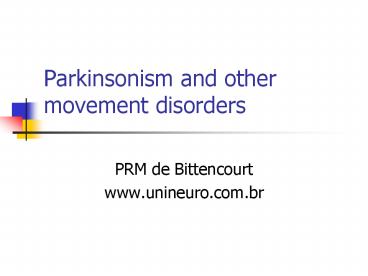Parkinsonism and other movement disorders - PowerPoint PPT Presentation
1 / 25
Title:
Parkinsonism and other movement disorders
Description:
It was thought Parkinson's evolved without dementia, with ... Wedding invitations, model ships and airpplanes. Physical exercise. Extremely healthy life ... – PowerPoint PPT presentation
Number of Views:355
Avg rating:3.0/5.0
Title: Parkinsonism and other movement disorders
1
Parkinsonism and other movement disorders
- PRM de Bittencourt
- www.unineuro.com.br
2
The concept of Parkinsons disease
- 1977 started classical neurology training
- 1982 first started with a large amount of
clinical work - 1985 depression definitely associated with
Parkinsons, imipramine replaced other
anticholinergics
- It was thought Parkinsons evolved without
dementia, with depression, perhaps dementia at
the end - Initial surprise at the great number of cases
cured of Parkinsons disease
3
The most frequent cause of parkinsonism in
Curitiba in the 80s labirintitis
- 1988 Chouza e Melo-Souza, parkinsonism due to
cinarizine and flunarizine - 100. Cunha CA, Bittencourt PRM, Kohlscheen KL,
Mercer LM. Reversible parkinsonism induced by
cinarizine and flunarizine. Revista Médica do
Paraná 5013-16, 1993
- Letter to CD Marsden in 1986
- 1988 Dr Marsden diagnosis is really difficult
- Recommended a number of criteria
4
Present vision (Litvan 2003)
- Pathologically, patients with parkinsonism and
dementia may be classified as tauopathies or
sinucleinopathies, based on their aggregates of
abnormal proteins
- There are no biologic markers at the moment that
allow the diagnosis of the various disease that
start with parkinsonism or dementia, and their
clinical diagnosis may be a challenge
5
Parkinsonism with dementia
- tauopathies (PSP, Pick disease)
- synucleinopathies (Parkinson, dementia with Lewy
bodies - Drug-induced (combination of drugs,
anti-cholinergics, or dopaminergics) - Infeccious (Creutzfeldt-Jakob, HIV)
- Vascular
6
Parkinsonism with dementia
- Toxic (Wilson, manganese)
- Tumoral (primary, secondary, chronic subdural
hematomas) - Normal pressure hydrocephalus
- Post-traumatic (dementia pugilistica)
- Sleep apnoea
7
synucleinopathies
- Parkinsons
- akynesia postural disturbance with axial
involvemente, rigidity, response to L-PODA - Lewy body disease
- Demential more proeminent
- More rapidly progressive
- N response to l-DOPA
8
tauopatias
- Familial
- Frontotemporal lobe dementia with parkinsonism
associated with chromosome- 17
- Frontal behaviour (disinhibition, isolation,
disfunction executive aphasia) parkinsonism
9
Typical Parkinsons patient
- 60 year-old, male, non-smoker, brought by family
or refered by clinician due to - Slowness
- Lack of volition, apparent sadness
- Motor difficulty with every day activities
- Sleep disturbances
10
Typical Parkinsons
- Consults other physicians because
- Labyrinth (dizzines, postural instability, gait
difficulty, apparent lack of balance) - Vertebral column lumbar pain, difficulty moving
legs
11
Physical Examination
- Posture parkinsonian
- Gait parkinsonian
- Slowness of movemento rigidity
- Lack of movement akinesia
- Tremor
- Asymetric signs
12
On physical exam
- Cardiovascular, respiratory, abdominal, head,
neck, limbs normal - Movement thought slow
13
Diagnosis therapeutic test
- Response to l-DOPA
- Immediate
- Dose-dependent
- 3/3h
- ¼ de 250mg
14
Medical diagnosis
- Systemic investigation normal
- Neuroimaging normal
- CT
- MRI
15
Diagnosis functional
- Neuroimaging functional normal
- SPECT
- PET
- EEG with mapping of alpha at low normal
16
Functional diagnosis
- IQ Memory normal
- WAIS
- Weschler Memory Scale
- Minimental
17
Natural history until 80s
- 1-2 years before diagnosis
- 5 years good response to L-DOPA
- 5 years partial incapacity with multiple drugs
- 2-3 years with terminal incapacity
- Dysphagia aspiration
18
Natural history after the 80s
- 1-2 years before diagnosis
- 5 years good response to post-DA stimualtors
pramipexole - 5 years good response to small doses of L-DOPA
given at short intervals or SR multiple drugs - 5 years partial incapacity with multiple drugs
- 2-3 years with terminal incapacity
- Dysphagia aspiration
19
História natural após ano 2000
- 12 anos de diagnóstico, resposta a estimuladores
pós sinápticos pramipexole, pequenas doses de
L-DOPA ou SR múltiplos medicamentos - 5 anos de incapacidade parcial com múltiplos
medicamentos ou estimulador de gânglios da base
com retorno quase ao estado inicial, em pacientes
com menos de 70 anos - 2-3 anos de incapacidade terminal
- Disfagia broncoaspiração
20
Multiple drugs
- Tricyclics, venlafaxine, bupropione
- entacapone
- quetiapine
- Avoid anticholinergic effect
- Avoid depressive effect
21
Environmental treatment
- Collection of cars versus mechanic
- Ballroom dancing, snooker, tricot
- Wedding invitations, model ships and airpplanes
- Physical exercise
- Extremely healthy life
- Repetitive routine with novel fine and physical
motor and mental acitvities
22
Essential tremor
- Familial ou episodic
- Rapid, action, symetric, diffuse
- Propranolol, alcohol, phenobarbitone
- Caffeine, dopaminergic substances
- Benign
- Cigarrete
23
Dystonias
- Tardive dyskinesia
- Psychogenic dyskinesia
- Focal dystonia
- Facial hemispasm
- Generalized dystonia
- Dystonic cerebral palsy
24
Choreas
- Sydenham
- pregnancy
- Huntington
- Drug induced
- Antipsychotic
- Metochlopramide
- Fluoxetine
- L-DOPA
25
Chorea, dyskinesia, dystonia
- Botox
- Anticholinergics
- Mood stabilizers
- DA blockers
- Benzodiazepines































